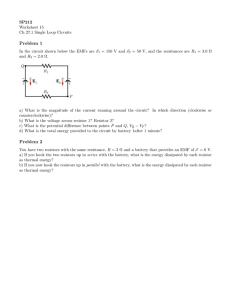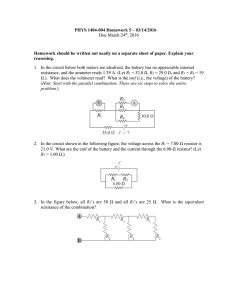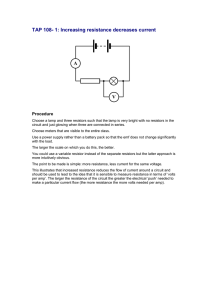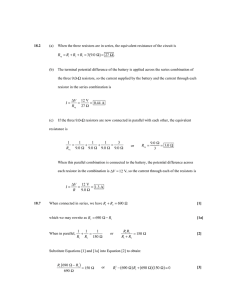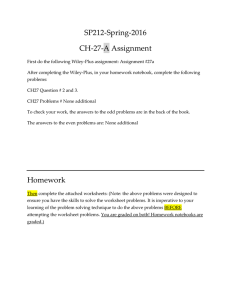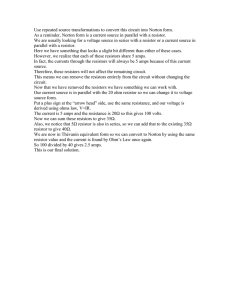Multiple Choice Questions
advertisement
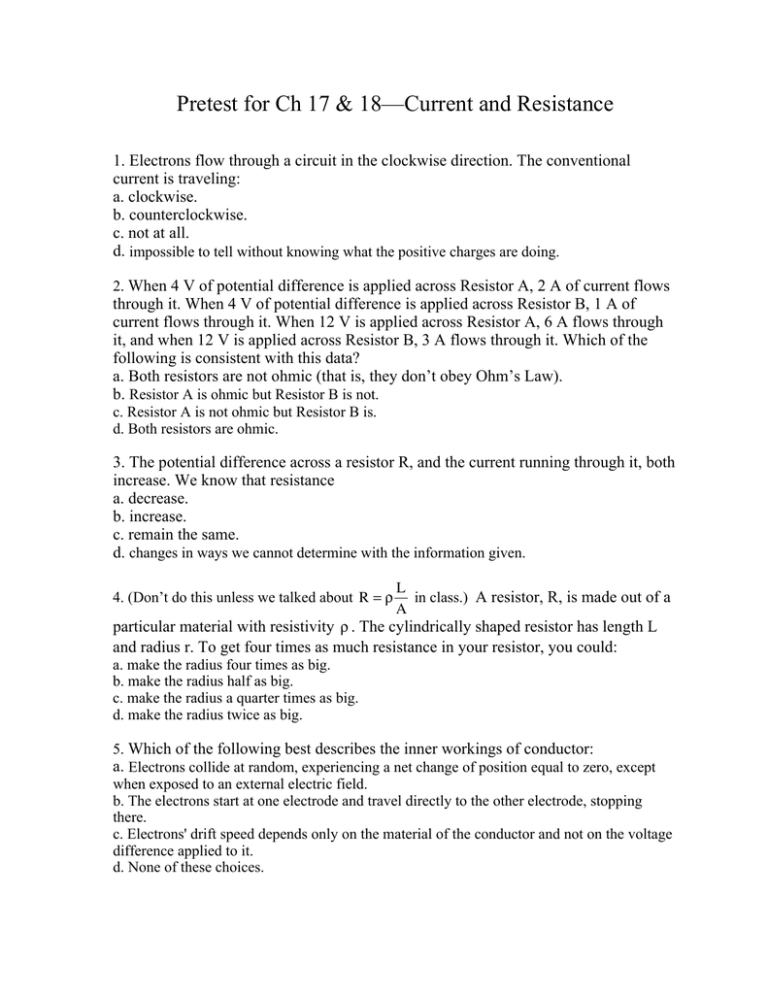
Pretest for Ch 17 & 18—Current and Resistance 1. Electrons flow through a circuit in the clockwise direction. The conventional current is traveling: a. clockwise. b. counterclockwise. c. not at all. d. impossible to tell without knowing what the positive charges are doing. 2. When 4 V of potential difference is applied across Resistor A, 2 A of current flows through it. When 4 V of potential difference is applied across Resistor B, 1 A of current flows through it. When 12 V is applied across Resistor A, 6 A flows through it, and when 12 V is applied across Resistor B, 3 A flows through it. Which of the following is consistent with this data? a. Both resistors are not ohmic (that is, they don’t obey Ohm’s Law). b. Resistor A is ohmic but Resistor B is not. c. Resistor A is not ohmic but Resistor B is. d. Both resistors are ohmic. 3. The potential difference across a resistor R, and the current running through it, both increase. We know that resistance a. decrease. b. increase. c. remain the same. d. changes in ways we cannot determine with the information given. 4. (Don’t do this unless we talked about R = ρ L in class.) A resistor, R, is made out of a A particular material with resistivity ρ . The cylindrically shaped resistor has length L and radius r. To get four times as much resistance in your resistor, you could: a. make the radius four times as big. b. make the radius half as big. c. make the radius a quarter times as big. d. make the radius twice as big. 5. Which of the following best describes the inner workings of conductor: a. Electrons collide at random, experiencing a net change of position equal to zero, except when exposed to an external electric field. b. The electrons start at one electrode and travel directly to the other electrode, stopping there. c. Electrons' drift speed depends only on the material of the conductor and not on the voltage difference applied to it. d. None of these choices. 6. The battery powering a light bulb is disconnected. As the light bulb's heat dissipates, how will the resistance and current change? a. The resistance will decrease and the current will increase. b. The resistance will increase and the current will be zero. c. The resistance will increase and the current will decrease. d. The resistance will decrease and the current will be zero. 7. (Don’t do this unless we talked about R = ρ L in class.) A length of wire has a A resistance R. The wire is then uniformly stretched to double its original length. What resistance results. Hint: When the wire is stretched, its volume remains constant. a. R/2 b. R c. 2R d. more than 2R 8. Three resistors are connected in series in a circuit. The resistors A, B, and C have resistances R, 2R, and 3R, respectively. Which resistance dissipates the most power? a. A b. B c. C d. they all dissipate the same amount of power when in series. 9.) The current through a resistor doubles. Because of the heating, the resistance also doubles. If the original power dissipated by the resistor was P, what is the final power dissipated? a. 4P b. P/4 c. 8P d. P/8. 10. An electric heater is operated with a potential difference of 100 V. If the heating element has a resistance of 20 ohms, what is the power output of the heater and what is the current through it when operating? a. 2000 watts, 5 amps b. 2000 watts, 25 amps c. 500 watts, 5 amps d. 500 watts, 25 amps 11. A circuit element uses 50 watts of power. The current running through it is 5 A. Which of the following could be the circuit's resistance and potential difference? a. 10 V, 2 Ω b. 20 V, 8 Ω a. 20 V, 5 Ω b. 15 V, 4.5 Ω 12. A battery with an emf of 12 V theoretically supplies 4 A of current to the circuit's load if internal resistance is not taken into consideration. When the internal resistance is included, the current is calculated to be 3 A. The load's resistance, R, and the internal resistance, r, are a. R = 1 Ω, r = 3 Ω b. R = 1/3 Ω, r = 11/3 Ω c. R = 3 Ω, r = 1 Ω d. R = 3 Ω, r = 4 Ω 13. In order to calculate the fraction of the total power delivered to the load resistor in a circuit consisting of a battery and a load resistor, one needs to know only the a. load resistance b. internal resistance c. load resistance and internal resistance. d. load resistance, internal resistance and EMF 14. A battery placed in circuits with different load resistances can be considered as a source of constant a. EMF b. current c. terminal voltage d. none 15. As more resistors are added in series, the equivalent resistance of the circuit approaches infinity. In contrast, as more resistors are added in parallel, the equivalent resistance a. approaches infinity. b. approaches zero. c. becomes zero. d. approaches 1 Ω 16. A circuit has two identical resistors, each with resistance R, connected in series. They add to give an equivalent resistance of 2R. If any internal resistance is negligible, which of the following would increase the current in the circuit the most? a. add another resistor, R, in series b. take away one of the resistors c. add another resistor, R, in parallel to the two already in series d. it depends on whether the resistance is greater or less than 1 Ω 17. Three wires, each carry 2 A, flow into a junction. From that junction emerge two other wires carrying the current away. What could the current in those two wires be? a. 2 A b. 6 A c. 3 A d. 4 A 18. A loop containing N identical resistors includes a battery with an emf of 10 V. If we start the loop at the battery's negative terminal, proceed through the battery and then through the resistors back to the negative terminal of the battery, the potential difference across each resistor and the number of resistors could be a. 3 resistors, -7 volts b. 5 resistors, 2 volts c. 9 resistors, 1 volt d. 2 resistors, -5 volts 19. Three different resistors are connected in parallel. If R1 < R2 and R2 < R3, their equivalent resistance when connected is: a. between R1 and R3. b. less than R1. c. neither between R1 and R3 nor less than R1. d. depending upon the order in which they are attached in parallel. 20. Two 3- Ω resistors are connected in series. Another 3- Ω resistor is then connected in parallel to the two already in series. The resulting combination has what resistance a. 1 Ω b. 2 Ω c. 4 Ω d. 5 Ω 21. Kirchhoff's loop rule is equivalent to which of the following principle a. conservation of charge b. conservation of energy c. conservation of mass d. conservation of force 22. A 120-V circuit has a breaker rated at 10 amps. If a 1050-W toaster is operating on this circuit, what is the largest number of 100-W bulbs that may also operate simultaneously on this circuit without tripping the breaker? a. 0 b. 1 c. 2 d. more than 2 Solutions: b, d, d, b, a, d, d, c, c, c, a, c, d, a, b, c, c, d, b, b, b, b

